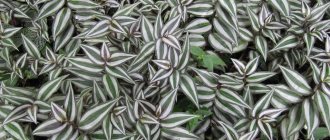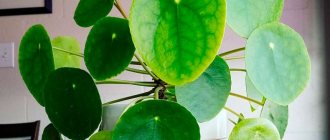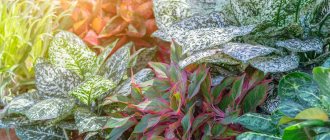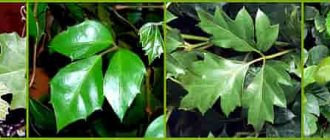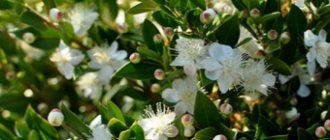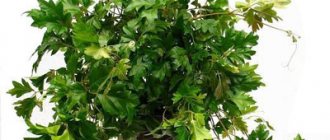Features of Pilea
Pilea is a hardy plant, reaching a height of 0.4 m and having decorative foliage. This plant is most often grown in winter gardens, warm flower beds and display cases. Pilea Cadieu differs from other species in its very rapid growth, which is of particular value for gardeners who use it when arranging compositions of various flowers. Small unisexual flowers are most often collected in axillary racemes. The plant distributes its fruits in an extremely unusual way, which is similar in its mechanism to ejection. By the time of fruiting, the sterile stamens (staminodes) grow greatly and only slightly support the fruit hanging over them. In a ripe fruit, the connection with the plant is greatly weakened. At this time, the sterile stamens straighten and throw the fruit up to a distance of one hundred meters.
Caring for Pilea at home. Briefly
| Temperature | In summer 19-23 degrees, in winter 15-17, but not lower than 10 degrees. |
| Air humidity | High. |
| Lighting | Pilea at home needs bright, diffused light; east or west window. |
| Watering | Moderate; in summer 2-3 times a week, in winter 1 time a week. |
| Priming | Medium fertile with a neutral or slightly acidic reaction, permeable to water. |
| Feeding and fertilizer | During the growing season, apply liquid complex fertilizer once every 2 weeks. |
| Transfer | Once a year, in spring in wide pots. |
| Reproduction | Stem cuttings. |
| Features of cultivation | Does not tolerate drafts well and needs pruning and pinching. |
Transfer
When choosing a flower pot, you should choose a small one, since the root system of the Cadieu pilea is superficial and compact.
It is necessary to replant the plant in the following cases:
- 1-3 weeks after purchase;
- as needed, when the root system becomes crowded in the pot. Signs for urgent transplantation: roots entwine holes in the bottom of the pot; the leaves begin to dry;
- annually, if pinching is not done on time;
- every 2-3 years when the bush ages. This operation is usually performed in the spring. The plant is cut to a height of 10-15 cm, taken out of the pot, the root system is divided and rooted again in the pot.
Signs and superstitions
Do you believe in signs and superstitions associated with this flower?
I believe I don't believe
Pilea has a positive effect on the atmosphere in the home. When around her, people's anxiety decreases and their mood improves. Suitable for those who practice: in her presence it is easier to enter a meditative state.
It is a talisman for those born under the sign of Pisces. It is believed that Pilea Peperomiiformes has special energy and attracts money into the house, which is why it is also called the Chinese money tree.
According to floral feng shui, you should not keep fading plants at home - they take away vital energy. Give flower pots a place away from the bed and sofa. It is better not to place plants in the bedroom at all. But an excellent solution would be to fill empty niches and corners with them.
Expert opinion
Mokhov Andrey Petrovich
Graduated from KubSAU, specialty: agronomy
Pilea is not suitable for growing as a bonsai, but feels great in open and closed florariums.
What flowers can you keep at home?
Flowers significantly decorate the interior, please the eye and improve the psychological atmosphere. Below we will talk about what flowers can and should be kept at home for well-being.
Uzumbara violet
Another name for the Uzumbara violet is “flower of love.” It is best if it is white - then there will be peace, happiness, love and harmony in the family. Pink and blue violets are best placed in the kitchen.
Aloe is a healing flower, rumors about its harm are nothing more than a fairy tale. Since ancient times, this plant has brought only good energy to the house; the juice of this plant is added to many cosmetic products, as well as medicines.
aloe is a medicinal house plant
Myrtle is considered a very positive plant; it is strongly recommended to keep it in the house. Myrtle brings quick love to unmarried girls, and long and strong marriage to married girls. Myrtle is often given to newlyweds on their wedding day as a symbol of love.
Anthurium
Anthurium is considered a male plant; it literally attracts male energy into the house and gives happiness to all single girls. Thanks to Anthurium, family relationships improve, quarrels and squabbles leave the house, and a pleasant aura appears.
Schlumberger's Decembrist
Schlumberger's Decembrist got its name because it blooms in winter, in December. This flower literally spreads “vibes of happiness and goodness” around itself. Even selfish people become better people with it. It is believed that if this plant begins to bloom at the wrong time, it is only because there is a favorable atmosphere in the house.
Ficus
Ficus definitely has no place in the bedroom; it is best to place it in another room. Ficus has powerful energy that can drive away negativity and aggression from the home. Some believe that ficus can bring peace and tranquility to the home, as well as cope with anxiety and depression.
ficus will be useful for people's energy, but it is better not to place it in the bedroom
Conditions of detention
Light
Pilea prefers soft, diffused light or partial shade. The best places to keep the culture are window sills in the west and east. It is acceptable to place a flower pot near a window on the south side.
In cloudy weather and periods of short daylight hours, you can use special devices. For example, phytolamps are perfect.
Temperature
Despite its southern origin, the culture does not like heat. The best temperature regime will be moderate. During the warm period, it is advisable to maintain 19-23 degrees above zero. In winter, it is worth placing the plant in a cool place (at 14-18 degrees). The only exception is the wrapped pilea. This variety becomes cold already at 18 C.
It is also important to exclude drafts and strong temperature changes. This applies to all types.
What kind of soil is needed?
Land for Pilea can be purchased in specialized stores or prepared yourself. The composition is not complicated: humus, leaf soil, peat and sand in a ratio of 2:2:1:1.
Expert opinion
Mokhov Andrey Petrovich
Graduated from KubSAU, specialty: agronomy
If you make the mixture yourself, do not forget about disinfection. To do this, the soil needs to be calcined or frozen. It is also recommended to soak it in a solution of potassium permanganate to protect it from pests.
In the store, choose a mixture for decorative foliage flowers with an acidity pH of 5.5–6. A couple of hours before use, stir the soil to saturate it with oxygen. The purchased option is often the best, because maintaining proportions is not everything. It is difficult to find high-quality soil without impurities and diseases.
Even peat taken from the shore of a reservoir may not be suitable for indoor plants. Therefore, the ready-made mixture has more advantages than it seems. The only drawback is the price, but the result is worth it.
Do not forget about drainage, because the roots of the pilea do not tolerate stagnant moisture. You can use crushed bricks, pebbles, gravel, ceramic shards or expanded clay. When choosing a pot, choose a shallow, spacious option: the flower quickly grows in width, and the root system is superficial.
Pilea propagation
When propagated at home, Pilea is propagated by cuttings.
The procedure can be carried out throughout the year, but the optimal time is spring: the pilea takes root faster and grows with young shoots.
Cuttings 7-10 cm long with 2-3 pairs of leaves are suitable for propagation. They should be planted in sand or adult plant substrate and covered with polyethylene or glass. The “greenhouse” is placed in a warm place, protected from direct sunlight, regularly ventilated and watered. When the cuttings have taken root and new leaves have appeared, the polyethylene or glass is removed.
Freshly cut cuttings can be placed in water, and when they have roots, they can be planted in individual pots. You can plant 2-3 cuttings in one container - such a bush will be more lush.
Good signs about indoor plants
There are plants that carry positive energy and are suitable for everyone. Crassula, or Crassula, attracts the energy of money into the house. With proper care and conditions for growth, it will help you get rich. Choose a pot for it red or green - the colors of money magic. Place coins in it when planting Crassula.
The fern protects against harmful radiation from electrical appliances, so place it near the TV or computer. This property allows them to replace the usual cacti; negative signs are associated with them.
Another name for spathiphyllum is women's happiness. This plant carries one positive energy - it brings family happiness and prosperity. You can read more about the meaning of spathiphyllum in a separate article on the website.
Bamboo carries the energy of career growth, the desire for success and good luck in business and at work. But it brings happiness when a pot with a plant is placed on the desktop. In the bedroom, near the bed, such aspirations are useless.
Aloe serves as a normalizer for family relationships and communication with guests, and brings peace and tranquility to the home. This plant will protect against unwanted visitors and their influence. Therefore, they are placed near the entrance to the room.
Breed sour wood when you have problems finding a suitable partner or in a relationship with the existing one. It normalizes family and love relationships.
Hibiscus is a flower of love and passion. Perfect for newlyweds and older couples. Helps in strengthening and restoring normal family relationships. Avocado has a similar meaning.
Tradescantia protects the owner from gossip, and aspidistra adds strength to character.
Ficus is a plant that gave Adam and Eve leaves to hide their nakedness and fruits (figs are a type of ficus) to satisfy hunger. It is considered the patron of the hearth and home, bringing prosperity and good luck. Read about the signs about ficus trees.
Chlorophytum purifies the air and, according to signs, brings happiness to family members.
Violet helps resolve conflicts peacefully. When there are scandals in the house, plant violets. Find out about the signs about violets.
Geranium fights stress, loneliness and depression, and also boosts confidence. It makes a person’s character calm and balanced.
Dracaena improves mood, shares energy, brings good luck and success.
All citrus plants are favorable for placement in the home. They bring good luck, happiness, wealth and love.
House roses symbolize fidelity and chastity. When you are worried about your teenage daughter, place a box of roses, preferably white ones, in her room. In the matrimonial bedroom, marriage is protected from betrayal and deception.
Transplantation
It is recommended to replant the Pilea annually. The most recommended time of year for this is spring. The choice of pot depends on the combined shape and size of all the roots. So, the container for the pilea should be spacious, but not very deep.
The plant will take root especially well in soil containing humus. To ensure that the liquid in the roots does not stagnate, it is necessary to ensure high-quality drainage of the liquid.
Diseases and pests
Pilea is a fairly hardy plant. However, if the basic rules of caring for it are not followed, difficulties may arise. Here are the main problems and the reasons for their occurrence:
- The lower leaves of the Pilea fall off - incorrect watering regime (excess or lack of moisture).
- Pilea leaves turn black - the temperature is too low.
- Pilea leaves droop - insufficient watering.
- Pilea shoots are stretched - lack of sunlight.
- Drying spots appear on the leaves - these are burns due to direct rays of the sun hitting the plant.
- The lower parts of the branches become bare - the bush is degenerating and needs rejuvenation.
Among the pests, Pilea can be affected by aphids, scale insects, spider mites, and thrips.
Difficulties in growing
Unique cyclomenia flower
If planting and care recommendations are followed, Pilea rarely gets sick or becomes infected with harmful insects. Such misfortunes can accompany it at high air temperatures, dry indoors, excessive watering, and lack of fertilizing.
Among the diseases, the flower can be affected by root rot. It develops in cool conditions with waterlogging. Diseased roots need to be cut off, healthy ones should be washed with hot water, and the cut areas should be treated with activated charcoal, a fungicide approved for indoor plants.
Then the roots need to be dried for 24 hours and transplanted into a new pot and soil.
Important! Work with chemicals at home must be done in a well-ventilated area with hands and face protected. During treatments, it is forbidden to drink, eat or smoke. Among the pests that are dangerous for Pilea:
Among the pests that are dangerous to Pilea:
- Spider mite. A characteristic sign of the presence of a mite on a plant is that the leaves and stems are entwined with cobwebs, and there are small red dots on the foliage. This parasite loves heat and dryness. To get rid of it, you need to wipe the flower with soapy water. In case of severe infection, treatment with Fitoverm, Bi-58, Karate, Iskra-M, and Aktellik is necessary.
- Shield. This is a small insect covered with a hard shell. It feeds on the juices of the flower. The first symptoms of scale insects are a sticky liquid on the trunk. They destroy it mechanically - by scraping it off with a brush. Vinegar rubs and rubs with tincture of garlic and red pepper are also effective. In case of severe infection, they resort to chemical treatment using Fitoverm, Actellik, Metaphos.
- Thrips. The presence of these parasites is indicated by small holes on the leaves, brown spots, and deformation of the stems. Dry air promotes their reproduction. The flower is treated by spraying with insecticides “Aktellik”, “Inta-Vir”, “Fitoverm”, “Aktara”, etc.
In addition to ailments and parasitic insects, the following problems may occur when growing a plant:
- Lightening and shrinking of foliage, drying out of the ends of the leaves. Such changes in the appearance of the flower indicate a lack of sunlight. It is necessary to change the location of the plant to a lighter one.
- Leaf fall, wilting of stems. They talk about over-hydration. It is necessary to reduce the volume and number of waterings.
- The leaves wrinkle and dry out. This is how the plant reacts to high or too low temperatures and a long absence of watering. It is necessary to control the temperature in the room and bring it to the recommended values and establish a humidification regime.
- Formation of brown, brown or yellow spots. These are sunburns. The plant needs to be protected from them.
- Falling leaves of the lower tier, exposure of shoots, collapse of the bush. Such a deterioration in the condition of the flower is a signal that it needs to be rejuvenated.
So, Pilea is a compact indoor plant that does not require special care efforts or special conditions. The variety of varieties and species allows the flower to be planted as an hanging plant and in compositions with other crops, for example, begonia, ivy. It looks great in hanging flowerpots, on shelves, and flower stands.
Types of Pilea domestica with photos and names
Pilea peperomioides
Forms a compact bush, up to 45 cm high. On a rigid stem, rounded leaves on long petioles are placed oppositely. The leaf blade, up to 7 cm in diameter, is smooth, green in color, and slightly bent inward.
Cadie's Pilea, Silver Pilea (Pilea cadierei)
A bushy plant, up to 40 cm high. Young stems are erect, mature stems lean towards the soil and branch strongly. The leaves have an elongated oval shape, up to 5 cm wide, up to 20 cm long. The green leaf plate with three veins has two silvery lines along it. Small flowers are collected in axillary inflorescences.
Pilea microphylla
Perennial herbaceous plant, up to 15 cm high. Arched light green shoots are highly branched. They have many miniature light green leaves, up to 0.5 cm long, placed opposite them. The leaf blade is glossy, oval or round in shape. In the axils of the leaves, tiny flowers, both unisexual and bisexual, are collected in corymbose inflorescences.
Pilea filamentous (Pilea numiralifolia)
An ampelous plant with thin reddish shoots. Small rounded leaves, up to 1 cm long, are alternately placed on them. The underside of the leaf plate is painted purple.
Pilea involucrata
A herbaceous plant with erect or creeping stems, up to 30 cm high. The opposite leaves are oval in shape and have pronounced serrated edges. Their length reaches 7 cm. The leaf plate is tuberous, light green in color, and brown in the area of 3 longitudinal veins. This species is used to create hybrids.
Popular varieties
This crop is not loved for its abundant flowering, although buds appear very rarely at home. This usually happens in the summer season. The flowers are small, white, monochromatic, collected in dense inflorescences. Against the background of bright foliage they are almost invisible.
The following varieties are in greatest demand among gardeners:
Pilea Cadiera
The height of the stems can reach 40 cm. Over time, they begin to branch. The leaves are oval-shaped with a pointed tip and three veins. Other popular names for the species are silver pilea, aluminum plant, which were given to it due to its striking colors. The bright green (or bluish-green) surface of the foliage is covered with two wide, intermittent stripes of a silvery hue.
Pilea adpressed
The leaves are light green, small, numerous. The bushes are squat and curly.
Pilea Alumi
The foliage is colored richly green, has a wrinkled, terry surface with veins of a crimson hue.
Other popular varieties of Pilea include:
- coin-leaved;
- thick-leaved;
- wrapped;
- peperomyoid;
- Lebanese;
- small-leaved;
- creeping.
Cadieux is one of the most common types of Pilea, famous for its variegated leaf color. The plant is unpretentious, so even a beginner can cope with its maintenance. Knowing what Pilea Cadieu is - home care, cultivation, propagation - will help you successfully cope with the task.
Source
Photo of Pilea
Video about the topic
In the interior, pilea is often used as an hanging plant. But it also looks great in compositions with bare-barrel neighbors. The flower gained particular popularity with the advent of fashion for simplicity and conciseness.
Which Pilea did you like, what type would you like to have?
- Pylea spruce 22%, 5 votes
5 votes 22%5 votes – 22% of all votes
- Small-leaved 17%, 4 votes
4 votes 17%
4 votes – 17% of all votes
- Cadiera, Cadiere or silver 13%, 3 votes
3 votes 13%
3 votes – 13% of all votes
- Monetolistnaya 13%, 3 votes
3 votes 13%
3 votes – 13% of all votes
- Wrapped or its types 13%, 3 votes
3 votes 13%
3 votes – 13% of all votes
- Peperomyoid 13%, 3 votes
3 votes 13%
3 votes – 13% of all votes
- Creeping 9%, 2 votes
2 votes 9%
2 votes – 9% of all votes
Total votes: 23
Votes: 19
28.11.2018
×
You or from your IP have already voted.
Help us make the article better and more informative. Write in the comments what questions remain unanswered?
Loading…
general description
"Pilea coinifolia" is a tropical plant. In its homeland, South America, it lives in shaded areas of tropical forests that have enough moisture.
In indoor floriculture it is used as potted, ampelous and ground cover, for planting together with large, upright species of indoor flowers and trees.
This species is the shortest, with creeping stems and small leaves 1 cm in diameter , similar to coins. Thanks to these properties, it is popularly called the “Japanese dollar.” The surface of the leaves seems to be quilted, the color on top is green. And below is red-purple. The stems of this species are also reddish, in combination with the green foliage, they give “Pilea Monetolifolia” a special decorative appearance.
Pilea: home care
Pilea is a plant that does not require much attention from you, and which beginner gardeners can care for. There are many varieties of it. What’s interesting is that each type of pilea is strikingly different from each other. And if you were not specifically interested in other species besides the one you have, then when you see a pilea of another species, you may not even realize that it is essentially the same plant as yours. Of particular beauty are the Cadieus Pilea (cadieri) and the Norfolk Pilea involucres. But the most popular species are peperomyoid and small-leaved, although in my subjective opinion, they are inferior in appearance to the above-mentioned varieties.

